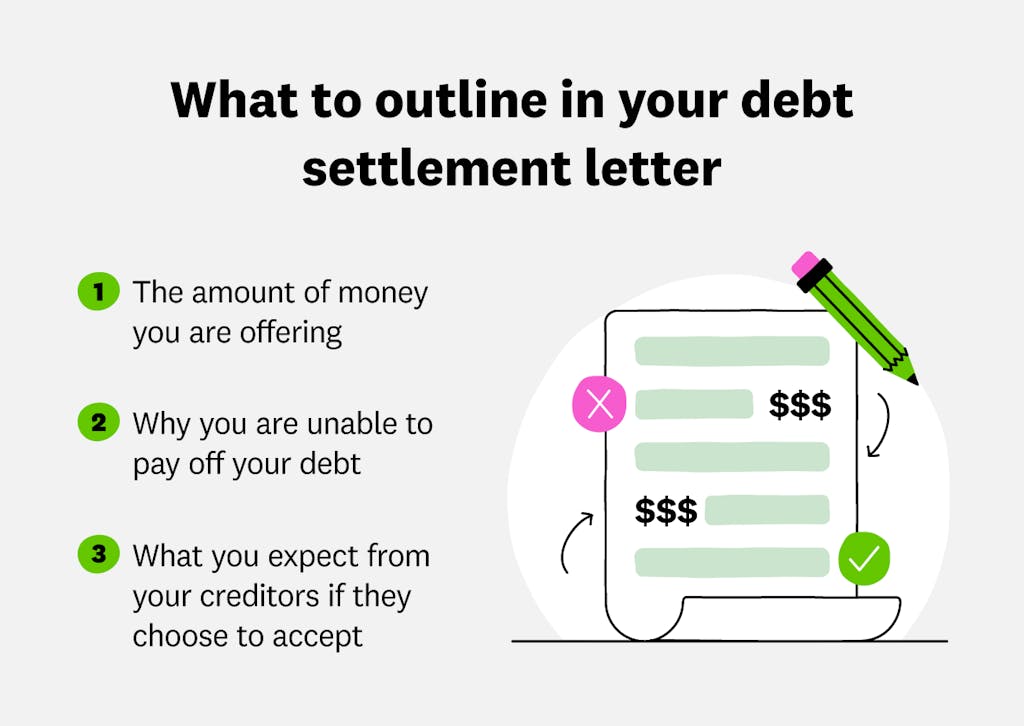If you’re unable to pay back your debt, you might want to learn more about debt settlement. Debt settlement can help you negotiate debt with your creditors to forgive all or part of your debt.
A debt settlement letter is a written proposal for you to offer a specific amount of money in exchange for the forgiveness of your debt. These letters address why you’re unable to pay the debt, how much you’re willing to pay now, and what you would like from the creditors in return.
Working through the proposal is how both parties determine the terms and agreements of a debt settlement exchange. Keep in mind that many third-party companies offer debt settlement services but typically charge a fee for their assistance.
- What is debt settlement?
- What to consider before sending a debt settlement letter
- How to write a debt settlement proposal letter
- What to expect after sending your letter
- What’s next: Other ways to consolidate your debt
What is debt settlement?
Debt settlement is the process of negotiating terms with your creditors in hopes of them forgiving a portion of your debt. People who pursue a debt settlement may do so because they can’t pay off their accumulated debt.
Instead, they can offer a decent portion of the debt owed upfront in exchange for closing the account in full.
Here are some key steps in reaching a debt settlement.
- Decide if you want to work on your own or hire debt settlement professionals. Professionals may help, but their fees also can get quite expensive.
- Save the amount you are proposing before even getting started. If the creditor accepts your proposal, you’ll likely need to pay the agreed amount within a specified time frame.
- Write a debt settlement letter to your creditor. Explain your current situation and how much you can pay upfront. Also, provide them with a clear description of what you expect in return, such as the removal of missed payments or the account shown as paid in full on your report.
- Ask for a written confirmation after settling on an agreement. Request this before you send the payment for an extra layer of liability coverage in the future.
- Send your payment and keep in touch with your creditors until all terms and agreements are fulfilled.
 Image: how-to-reach-a-debt-settlement
Image: how-to-reach-a-debt-settlementWhat to consider before sending a debt settlement letter
Sending a debt settlement letter has the potential to do both harm and good. The extent to which you are affected depends on your current situation.
Pros of writing a debt settlement letter
Sending a debt settlement letter can be helpful if you’re in financial hardship. It may prevent the need to file for bankruptcy. While settling is never a guarantee, it may put you in a better financial position.
If your request is accepted, debt settlement amounts settle on average for about 48% of the total balance, according to a 2017 Fair Credit Counsel report.
Reaching out to your creditors and addressing the issue can also relieve some of the stress you feel to pay off your debt.
Cons of writing a debt settlement letter
As noted, debt settlement is never a guarantee. If there’s no agreement made, you may end up owing more than you did originally due to missed payments and late fees. If you hire a professional, you may owe them fees and payments. Settling debt also may negatively affect your credit scores. Missed payments on the account may still appear in your report, even if you were negotiating your settlement during that time. There’s also a chance that your report displays a debt settlement note, which may hurt your ability to get credit in the future.
 Image: pros-and-cons-of-writing-a-debt-settlement-letter
Image: pros-and-cons-of-writing-a-debt-settlement-letterHow to write a debt settlement proposal letter
When you’re writing a debt settlement letter, it can help to be explicit and detailed. Think of the letter as a record between you and your creditor. If you decide to send one, it makes sense to include your personal information and account number for easy identification.
When preparing a proposed settlement, you should think about how much you can offer and what you hope to receive in return. It can help to have realistic expectations about what your creditor will accept.
When thinking about how much you can offer, make sure it’s an amount you can afford, leaving you with enough to cover other monthly bills and debts so you’re not replacing one debt with another.
To have your proposal approved, creditors will likely need reason to believe that you’re truly unable to pay off what you owe. Explaining why you cannot pay off all of your debt may benefit you, but on the flip side, it may also sow doubt with your creditor that you can cover the amount you propose paying.
Make sure to think about both sides when deciding what information to divulge. Financial hardships can include serious injury, unexpected loss of work and environmental disasters. Depending on your hardship, creditors may ask for documented proof. For instance, a serious injury may need proof from a doctor.
 Image: what-to-outline-in-your-debt-settlement-letter
Image: what-to-outline-in-your-debt-settlement-letterWhat to expect after sending your letter
After you send your letter, you may be eager to see if your creditor approves or declines the request. Including a response date in your letter may help your chances of a prompt reply. As you wait, ensure you have the agreed amount of money saved up and ready to go if they accept your offer. It can also be a good idea to request confirmation that the creditor has received your payment.
You may want to check and make sure the appropriate changes appear on your credit report and account. Debt settlement may relieve your debt, but it can also negatively affect your financial health, since you may appear as a risk to future lenders. Debt settlement may be worthwhile if you find yourself struggling because of a hardship or life-altering event. When writing a letter, remember it’s important to be careful with your words. A well-thought-out debt settlement letter can make all the difference, as it can help ensure that both parties uphold their part of the agreement.
What’s next: Other ways to consolidate your debt
If financial hardship is making it difficult to pay off debt, debt settlement isn’t your only potential solution. Here are some other options to consider.
- Credit counseling — Seek out a nonprofit credit counseling agency that can help you manage your finances and create a debt repayment plan. Keep in mind that they won’t necessarily negotiate debt for you.
- Debt consolidation loan — A personal loan used for consolidating debt may help you save money on high-interest credit card debt or other bills. Make sure to calculate your potential savings before you apply.
- Balance transfer card — You may want to explore transferring credit card debt with a balance transfer card, which may allow you to take advantage of a 0% APR introductory offer. But you’ll want to keep an eye out for balance transfer fees and add those to your potential costs.


